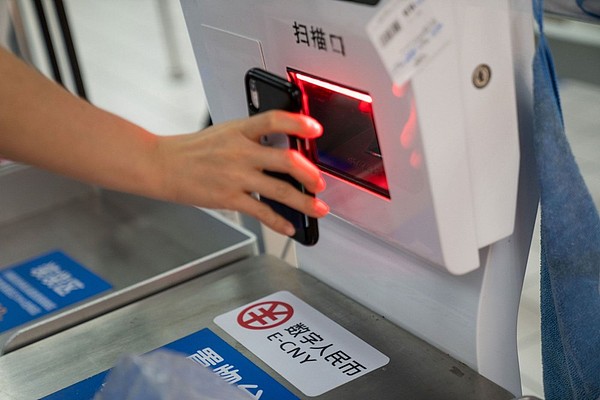The original title Why Wall Street is afraid of the digital dollar? 》, Source Bloomberg Businessweek
Compile | Baize Research Institute
Compile | Baize Research Institute
Imagine logging into your own account at the US Federal Reserve. With your laptop or mobile phone, you can use cash anywhere instantly. No middlemen, no fees, no waiting for deposits or payments to clear.
image description

Giancarlo. Photo: Andrew Haller/Bloomberg
Currently, the U.S. dollar remains the premier global reserve currency and the fiat currency of choice for international trade and financial transactions. But a new flavor of cryptocurrency could threaten that dominance, which is partly why the Federal Reserve Bank of Boston is already working to develop a prototype digital dollar platform at the Massachusetts Institute of Technology. Other governments, notably China, are leading the way in digitizing currencies. In these countries, regulators are concerned that as more people accept cryptocurrencies, the potential for fraud is multiplying.
Former President Donald Trumps Treasury Secretary Steven Mnuchin said he sees no immediate need for a digital dollar. His successor, Janet Yellen, has expressed interest in studying it. Support for a virtual dollar cuts across party lines in Congress, which will have a say in whether it becomes a reality. At a hearing in June, Sens. Elizabeth Warren, D-Mass., and John F. Kennedy, R-Louisiana, were open to the idea. Warren and other Democrats have highlighted the potential of a digital dollar to provide free services to low-income households who now pay high banking fees or are excluded from the system altogether.
image description

Digital yuan signs at a self-checkout counter in a supermarket in Shenzhen, China. Photo: Yan Cong/Bloomberg
Bai Ze Note:
The digital renminbi is named DC/EP, which contains two meanings, DC is digital currency, and EP is electronic payment. This means that DC/EP can be either a digital currency based on blockchain or distributed ledger technology, or a technology evolved on the basis of existing electronic payments.
The strongest opposition to virtual dollars will come from Bank of America. They rely on $17 trillion in deposits to fund much of their core business, profiting from the difference between the interest they pay account holders and the fees they charge on loans. Banks also make billions of dollars a year in overdraft, ATM and account maintenance fees. By creating a digital currency, the Fed is effectively competing with banks for customers.
In a recent blog post, Greg Bell, president of the Bank Policy Institute, which represents the industry, warned that homebuyers, businesses and other customers would find it harder and more expensive to borrow money if the Fed encroached on the interests of the private sector. Historic central role in finance. “The Fed will gain extraordinary powers,” wrote Bell, a former assistant Treasury secretary in the Clinton administration.
Some economists have warned that a digital dollar could destabilize the banking system. The federal government provides $250,0000 of insurance to bank depositors, a program that has successfully prevented bank runs since the Great Depression. But in a 2008-style financial panic, savers could, with a single click, take all their savings out of their banks and convert them into direct U.S. government debt. “In a crisis, this could actually make things worse,” said Eswar Prasad, a Cornell University professor and author of a book on digital currencies due to be published in September.
Whether a virtual dollar is needed is still up for debate. For large companies, cross-border interbank payments are already fast, limiting the appeal of digital currencies. Early adopters of bitcoin may have enjoyed an investment windfall as its value soared, but its volatility doesnt make it a reliable alternative to government fiat currencies like the dollar.
However, there is a new cryptocurrency called Stablecurrency, could pose a threat to the dollars dominance. Similar to other digital currencies, it is essentially a string of codes tracked and verified through an online ledger. But it has one key difference from bitcoin and its ilk: its value is pegged to sovereign currencies like the dollar, so it offers stability and privacy.
image description

Powell. Photo: Al Drago/The New York Times/Bloomberg
Regulators are also concerned about consumer protection. A stablecoin is only as stable as the network of private actors managing it on the network. If something goes wrong, holders may find themselves empty-handed. This prospect has put pressure on governments to come up with their own alternatives and fix the problems posed by stablecoins.
While the Federal Reserve has been working on the idea of a digital dollar since at least 2017, key details, including what role the private sector will play, remain unresolved. In the Bahamas, the only country with a central bank digital currency, authorized financial institutions can offer e-wallets to handle the Sand Dollar, the virtual counterpart to the Bahamian Dollar.
If savers flock to virtual dollars, banks will need to find another way to fund their loans. Advocates of a digital dollar have raised the possibility of the Federal Reserve lending money to banks so they can make loans. To help banks retain deposits, governments can also set caps on how much digital currency citizens can hold. In the Bahamas, the maximum amount is $8,000.
Lev Menand, a Treasury adviser to the Obama administration, warned against such compromises, saying the priority should be to deliver an unfettered central bank digital currency, or CBDC. Because the idea may require legislation, Congress faces a big decision: to create “a robust CBDC or a product like skim milk that would serve as an antidote to the big banks,” said Menand, who now teaches at Columbia Law School. A boon, this product has been watered down.










